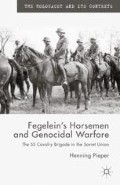Abstract
Whilst many different German military and paramilitary units involved in the Holocaust have been studied by researchers, not much has been written on the SS Cavalry Brigade due to a lack of access to files in Eastern European archives. This unit belonged to the Waffen-SS and played a special role both in the German war against the Soviet Union and the destruction of the European Jews.
Access this chapter
We’re sorry, something doesn't seem to be working properly.
Please try refreshing the page. If that doesn't work, please contact support so we can address the problem.
Preview
Unable to display preview. Download preview PDF.
Notes
Bernd Wegner, Hitlers Politische Soldaten: Die Waffen-SS 1939–1945 (Paderborn: Schöningh, 1988).
Zuzana Pivcová, ‘Das Militärhistorische Archiv in Prag und seine deutschen Bestände’, in: Militärgeschichtliche Mitteilungen 52 (1993), pp. 429–35.
See for example the books written by former members of the 8th SS Cavalry Division Florian Geyer: Hans-Otto Wachter, Wir funkten. Geschichte der Funkkompanie Nachrichtenabteilung 8 “Florian Geyer” (Kassel: self-published, 1979);
Hans-Otto Wachter, …und nur dafür! Erinnerungen und Gedanken ehemaliger Soldaten, die auszogen, um ihr Vaterland zu verteidigen (Kassel: self-published, 1984);
Hans-Otto Wachter, Als die Feuer brannten… Erinnerungen und Gedanken ehemaliger Soldaten, die auszogen, um ihr Vaterland zu verteidigen (Kassel: self-published, 1984);
Hans-Otto Wachter, Unsere Kavallerie-Division in der Dokumentation des II. Weltkrieges: Soldaten der “Florian Geyer” fotografierten (Kassel: self-published, 1984);
Hanns Bayer, Die Kavallerie der Waffen-SS (Heidelberg: self-published 1980).
Yehoshua Büchler, ‘Kommandostab Reichsführer-SS: Himmler’s Personal Murder Brigades in 1941’, Holocaust and Genocide Studies 1 (1986), pp. 11–25;
Ruth Bettina Birn, ‘Zweierlei Wirklichkeit? Fallbeispiele zur Partisanenbekämpfung im Osten’, in B. Wegner (ed.), Zwei Wege nach Moskau. Vom Hitler — Stalin-Pakt bis zum ‘Unternehmen Barbarossa’ (Munich: Piper, 1991), pp. 275–90.
Karla Müller-Tupath, Reichsführers gehorsamster Becher. Eine deutsche Karriere (Hamburg: Konkret-Literatur-Verlag, 1982). For this work I have used the significantly extended second edition, which was published by Aufbau in Berlin, 1999.
Paul J. Wilson, Himmler’s Cavalry: The Equestrian SS, 1930–1945 (Atglen, PA: Schiffer, 2000).
Martin Cüppers, Wegbereiter der Shoah: die Waffen-SS, der Kommandostab Reichsführer-SS und die Judenvernichtung 1939–1945 (Darmstadt: Wissenschaftliche Buchgesellschaft, 2005).
See also Martin Cüppers, ‘Vorreiter der Shoah. Ein Vergleich der Einsätze beider SS-Kavallerieregimenter im August 1941’, in T. C. Richter (ed.), Krieg und Verbrechen. Situation und Intention: Fallbeispiele (Munich: Meidenbauer, 2006), pp. 87–99.
Christopher Browning, Ordinary men: Reserve Police Battalion 101 and the final solution in Poland (3rd edition; Harmondsworth: Penguin, 2001);
Daniel Jonah Goldhagen, Hitler’s willing executioners: ordinary Germans and the Holocaust (London: Abacus, 1996).
Harald Welzer, Täter: wie aus ganz normalen Menschen Massenmörder werden (Frankfurt: Fischer, 2005), p. 14.
Sönke Neitzel and Harald Welzer, Soldaten. Protokolle vom Kämpfen, Töten und Sterben (Frankfurt: S. Fischer, 2011).
Andrej Angrick and others, ‘“Da hätte man schon ein Tagebuch führen müssen”. Das Polizeibataillon 322 und die Judenmorde im Bereich der Heesgruppe Mitte während des Sommers und Herbstes 1941’, in H. Grabitz and others (eds.), Die Normalität des Verbrechens. Bilanz und Perspektiven der Forschung zu den nationalsozialistischen Gewaltverbrechen. Festschrift für Wolfgang Scheffer zum 65. Geburtstag (Berlin: Ed. Hentrich, 1994), pp. 325–85;
Edward B. Westermann, Hitler’s Police Battalions: Enforcing Racial War in the East (Lawrence, KS: University Press of Kansas, 2005).
Andrej Angrick, Besatzungspolitik und Massenmord: Die Einsatzgruppe D in der südlichen Sowjetunion 1941–1943 (Hamburg: Hamburger Ed., 2003);
Helmut Langerbein, Hitler’s death squads. The logic of mass murder (College Station, TX: Texas A&M University Press, 2004).
Richard Rhodes, Masters of death: the SS-Einsatzgruppen and the invention of the Holocaust (New York: Knopf, 2002);
Ernst Klee and others (eds.), ‘Schöne Zeiten’: Judenmord aus der Sicht der Täter und Gaffer (Frankfurt: S. Fischer, 1988).
Kurt-Gerhard Klietmann, Die Waffen-SS. Eine Dokumentation (Osnabrück: Der Freiwillige, 1965);
George H. Stein, The Waffen SS: Hitler’s Elite Guard at War, 1939–1945 (Ithaca, NY: Cornell University Press, 1966);
Heinz Höhne, The Order of the Death’s Head: the Story of Hitler’s SS (London: Secker & Warburg, 1969).
See for example Herbert Walther, Die Waffen-SS. Eine Bilddokumentation (Wölfersheim-Berstadt: Podzun-Pallas, 1994);
Christopher Ailsby, Waffen SS: The Illustrated History, 1923–1945 (Minneapolis, MN: Zenith Press, 1998);
Tim Ripley, The Waffen-SS At War: Hitler’s Praetorians 1925–1945 (Minneapolis, MN: Zenith Press, 2004).
Jean-Luc Leleu, La Waffen-SS. Soldats politiques en guerre (Paris: Librairie Académique Perrin, 2007).
René Rohrkamp, ‘Weltanschaulich gefestigte Kämpfer’: Die Soldaten der Waffen-SS 1933–1945. Organisation — Personal — Sozialstrukturen (Paderborn: Schöningh, 2010).
Author information
Authors and Affiliations
Copyright information
© 2015 Henning Pieper
About this chapter
Cite this chapter
Pieper, H. (2015). Introduction. In: Fegelein’s Horsemen and Genocidal Warfare. The Holocaust and its Contexts. Palgrave Macmillan, London. https://doi.org/10.1057/9781137456335_1
Download citation
DOI: https://doi.org/10.1057/9781137456335_1
Publisher Name: Palgrave Macmillan, London
Print ISBN: 978-1-349-49841-3
Online ISBN: 978-1-137-45633-5
eBook Packages: Palgrave History CollectionHistory (R0)

